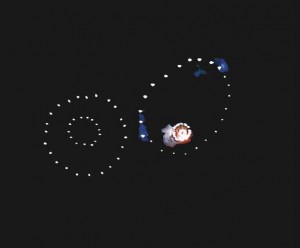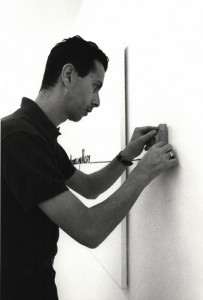dal 6 al 24 marzo 2017
A cura di Diletta Borromeo
UN’APPARENTE SEMPLICITÀ traspare dalle opere di Roberto De Simone. Con apparente semplicità egli si propone di Cerchiare l’infinito, un’impresa impossibile tentata con l’ausilio di fuochi d’artificio diffusi in un cielo notturno. Attraverso il video dell’azione (1993, VHS PAL trasferito su DVD nel 2007) De Simone esplicita un paradosso non privo di ironia e, al tempo stesso, la potenziale realizzazione di un’avventura che solo l’immaginazione può intraprendere. Fulcro del lavoro è una visione mentale che – spiega l’artista – “tenta di spogliare le coscienze soddisfatte delle loro formule cristallizzate e definite dalle leggi del senso comune”. Nella costruzione delle sue opere procede secondo un metodo razionale, espresso nei progetti, ma finisce per ribaltarlo nell’esito finale, dimostrando che è possibile pensare l’impensabile pur muovendo da conoscenze tecniche. Il titolo e la descrizione, redatti con parole meditate e scelte accuratamente, sono parte essenziale dell’opera, “un elemento fondamentale; il titolo è l’idea, il progetto”. E poiché egli sostiene che “il valore del lavoro è nell’idea, non nell’oggetto”, l’immagine e il titolo rimandano ad un’altra immagine corrispondente alla finalità del lavoro stesso, che si realizza attraverso l’adozione, richiesta anche allo spettatore, di un atteggiamento libero e anticonformista, con una vena di poesia e di leggera ironia. “Il vero artista crea una perturbazione collettiva delle coscienze per ricostruire la comprensione del reale in relazione con il mondo”. De Simone pone questioni, alla ricerca di un nuovo senso, dove la necessità della sospensione o dell’attesa di ciò che potenzialmente può compiersi, nello spazio e nel tempo, lascia aperti gli interrogativi. Centrale è l’intento di attivare una comunicazione con il pubblico. “Mi propongo sempre di innescare una riflessione che mi ha coinvolto per primo, e che spero interessi altri”. Parte di queste riflessioni è il tentativo di recupero della natura, intesa come cardine dell’esistenza e fonte primaria dell’energia, in cui l’artista concilia due apparenti antitesi: le proprie conoscenze scientifiche guidate dalle leggi della fisica e l’immaginazione prodotta dalla tensione verso l’invisibile. “La natura visibile è modellata sull’invisibile e a me interessa la natura in quanto spazio fisico in continuo divenire. Cerco di cogliere, di costruire delle relazioni con i fenomeni naturali soggetti alla temporalità, al mutamento da uno stato all’altro, di captare le forze e renderle visibili”. Cerchiare l’infinito comprende due progetti e alcune immagini estratte dal video, stampate su carta fotografica ed esposte nel 2007 insieme al filmato stesso.
Trait d’union fra i lavori in questa mostra è l’invito a produrre un paesaggio mentale, attivato grazie alle immagini in Cerchiare l’infinito, suscitato dai suoni in Il primo raggio di sole a Étretat con un grande vento calmo (2007). Quest’ultimo è un “ricordo sonoro” dell’artista legato a un luogo preciso, sulle falesie della Normandia. Si raccomanda di ascoltare la registrazione con le cuffie, a occhi chiusi, lasciando che il suono suggerisca colori, odori, luci e atmosfere, il senso dello spazio, “per avere un’immagine intima del paesaggio che si sta ascoltando. La realtà non è solo in sé, ma è qualcosa che si origina nell’atto stesso della percezione”.
-Roberto_De_Simone_Roma_1991 72_foto_Stefano_Fontebasso_di_Martino
Roberto De Simone (1954-2012) è nato e vissuto a Roma. Mentre si avvicina all’arte, studia Filosofia e Chimica inorganica. Sul finire degli anni settanta incontra Ettore Innocente ed Emilio Villa, con cui inizia un duraturo rapporto di stima e amicizia. Nello stesso periodo abbandona la ricerca sul segno pittorico e impronta il proprio fare artistico sul concetto di situazione. Da questo momento le letture filosofiche, le esperienze di vita, le domande sull’esistenza e sull’arte diventano elementi essenziali per comprendere la sua opera. A partire dagli anni ottanta la tecnologia e l’uso del linguaggio, talvolta sottilmente ironico, acquistano una sempre maggior rilevanza. L’amore per la vita e la natura, così come la fiducia nella scienza e nella tecnica svolgono un ruolo centrale nella sperimentazione, aperta alla realizzazione di performance e di lavori effimeri o incentrati su eventi possibili, talvolta non verificabili. Esemplare, nell’ambito della sua ricerca, è il lavoro I’ll do my best to paint the winds green in the Greenwich Park (1983) dove l’artista, grazie a un fumogeno collocato sulla cima di un’asta, per un breve lasso di tempo colora i venti di verde compiendo l’unione tra l’energia creativa dell’uomo e quella della natura.
Roberto De Simone ha esposto in spazi pubblici e privati, in Italia e all’estero. Fra questi London Video Arts, Londra (1983), Old Royal Observatory, Greenwich Park, Londra (1983), Ex Borsa in Campo Boario, Roma (1988), MLAC Museo Laboratorio d’Arte Contemporanea dell’Università degli Studi di Roma “La Sapienza” (1991), Studio Bocchi, Roma (1991 e 1995), Wiener Secession, Vienna (1993), Villa dei Quintili, Roma (2007), Galleria Horti Lamiani-Bettivò, Roma (2007), Evolution de l’Art Gallery, Bratislava (2007), Museo di Chimica dell’Università degli Studi di Roma “La Sapienza” (2009), Ippodromo di Capannelle, Roma (2010).
Recentemente, il suo lavoro è stato presentato nell’esposizione personale “Per dipingere i venti, per disegnare dal vero”, Colli independent art gallery, Roma (15 gennaio – 21 febbraio 2016) e nella antologica “FFFFFFFFFFFFFFF”, Palazzo Lucarini, Trevi (19 marzo – 8 maggio 2016).
In occasione della mostra alla Colli independent art gallery è stato pubblicato il volume a cura di Céline Brothier, Emanuele De Donno, Myriam Laplante, Roberto De Simone. I’ll do my best to paint the winds green, viaindustriae publishing, 2016.
AN APPARENT SIMPLICITY shines through the works of Roberto De Simone. With an apparent simplicity he resolves to Circle the Infinity, an impossible challenge attempted with the help of fireworks in a nocturnal sky. Through the video of the action (1993, VHS PAL transferred on DVD in 2007) De Simone expresses a paradox, not devoid of irony, and at the same time the potential realisation of an adventure that only the imagination can undertake. The cornerstone of this work is a mental vision that “tries to strip the satisfied consciences of their crystallized formulas, defined by the laws of common sense” – as the artist himself explains it. In constructing his works, the artist proceeds according to a rational method, expressed in the projects but overturned in the final outcome, as a demonstration that it is possible to think the unthinkable while still acting by means of technical knowledge. The title and description have been drawn up with thought-out words carefully chosen, because they are an essential part of the work – “a key element; the title is the idea, the project.” And since he claims that “the value of labour is in the idea, not the object”, the picture and title refer to another image corresponding to the purpose of the work itself, which is realised through the adoption, required of the viewer as well, of a free and nonconformist attitude, with a poetic and slightly ironic flair. “A true artist creates a collective disturbance of consciences in order to rebuild an understanding of reality in relation to the world”. De Simone highlights issues and looks for a new meaning, where the need for suspension or expectation of what could potentially be accomplished in space and time, leaves the questions open. The intent to activate a communication with the audience is key. “I always resolve to trigger a discussion that captivated me first, and that I hope others will find interesting”. Part of these reflections is the attempt to restore nature as the cornerstone of existence and primary source of energy, in which the artist combines two apparent antithesis: the scientific knowledge guided by the laws of physics and the imagination generated by a tension towards the invisible. “The visible nature is modelled on the invisible and I’m interested in nature as an ever-changing physical space. I try to seize, to build relationships with the natural phenomena subject to temporality, subject to change from one state to another, and to capture the forces and make them visible”. Circle the Infinity includes two projects and some images extracted from the video, printed on photographic paper and first exhibited with the film in 2007.
The liaison among the works in this exhibition is the invitation to produce a mental landscape, triggered by the images of Circle the Infinity, and evoked by the sounds of The First Ray of Sunshine in Étretat with a Great Calm Wind (2007). The latter is a “sound memory” of the artist linked to a specific location on the cliffs of Normandy. It is recommended to listen to the recording with headphones on and eyes closed, letting the sound suggest colours, smells, lights and atmospheres, the sense of space, “to have an intimate image of the landscape that is being listened to. The reality is not only in itself, but it is something that originates in the very act of perception”.
Diletta Borromeo
Roberto De Simone (1954-2012) was born and lived in Rome. While starting his first experiences in art, he studied Philosophy and Inorganic Chemistry. At the end of the seventies he met Ettore Innocente and Emilio Villa, with whom he started a lasting relationship of respect and friendship. At the same time he abandoned his search for a pictorial sign and imprinted his art with the concept of situation. From this moment his philosophical readings, life experiences and questions about existence and art became essential elements to understand his work. Since the eighties, technology and the use of – sometimes subtly ironic – language grew in importance. His love for life and nature, as well as his trust in science and technology, played a central role in his experimentations, which were open to the realisation of performances and ephemeral works or focused on possible, sometimes unverifiable events. Exemplary, as part of his research, is the work I’ll Do My Best to Paint the Green Winds in the Greenwich Park (1983), where the artist, thanks to a smoke bomb placed on top of a pole, coloured the wind of green for a short time, combining the creative energies of man and nature.
Roberto De Simone exhibited his works in public and private spaces in Italy and abroad, among which: the London Video Arts, London (1983), the Old Royal Observatory, Greenwich Park, London (1983), the Former Stock Exchange in Campo Boario, Rome (1988), the MLAC Laboratory Museum of Contemporary Art, University of Rome “La Sapienza” (1991), Studio Bocchi, Rome (1991 and 1995), Wiener Secession, Vienna (1993), Villa dei Quintili, Rome (2007), the Horti Lamiani-Bettivò Gallery, Rome (2007), Evolution de l’Art Gallery, Bratislava (2007), Museum of Chemistry, University of Rome “La Sapienza” (2009), Ippodromo Capannelle, Rome (2010).
Recently, his works were displayed at the Colli Independent Art Gallery, Rome, in the personal exhibition To Paint the Wind, to Draw Reality (15 January-21 February 2016) and at Palazzo Lucarini, Trevi, in the anthological exhibition “FFFFFFFFFFFFFFF” (19 March-8 May 2016).
A book on his work by Céline Brothier, Emanuele De Donno and Myriam Laplante, Roberto De Simone. I’ll Do My Best to Paint the Green Winds (VIAINDUSTRIAE publishing, 2016) was also presented at the Colli Independent Art Gallery in January 2016.

